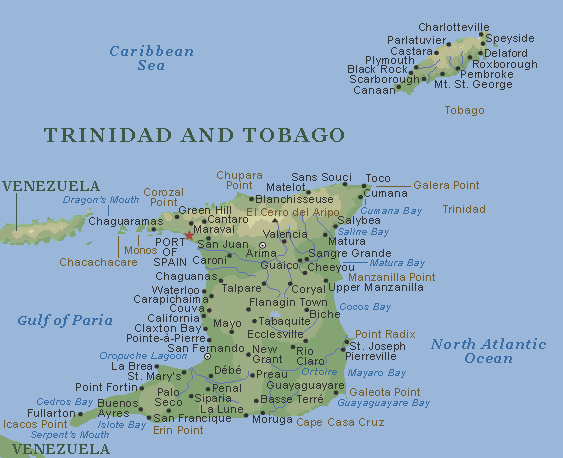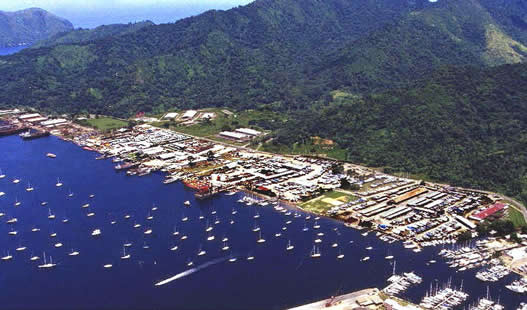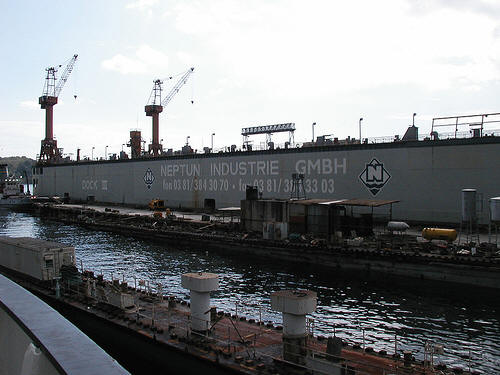

| We left Suriname on a grey Tuesday morning along with our Dutch friends, heading for Tobago with a 3-4 day schedule of squally weather. Our watermaker was not working but we had over 500 litres which was more than enough. Also we had no depth display on the instruments and needed to buy new ones. Two days into the trip our generator failed so Barry had to take it apart but couldn't fix it. This meant that we couldn't charge our batteries to run the instruments, lights, fridge and PC for navigation, without starting the main engine. Because of this we decided to divert to Trinidad where parts and services are plentiful. On Friday evening we were motoring along the north coast of Trinidad (no wind for sailing) when we hit a tuna net! The boat ground to a halt and there we were, in the middle of a busy waterway with big ships and ferries, surrounded by this huge very strong net. We called to the fishermen and asked them to help but no response. Barry tried to free the net from the rudder but caught his shoe and lost his watch in the process of trying to get out! The fishermen eventually came across in their small boat and cut away the net from around the hull - but this still left the net tangled in the propeller and the rudder. We were helpless, bobbing around and sometimes going backwards towards the fishing net. We couldn't start the engine, there was no wind and it was 45 miles to our destination. | |
 |
At 1030pm we called the coastguard and asked for advice/help and after a long
conversation about tugs/towing/meeting 30 miles away... we told them we
considered ourselves a hazard to shipping...and they referred the problem to
headquarters. Eventually they called back and said they would provide
assistance - so we waited. They called every half hour to check our position
(which was never far from the last position) but couldn't tell us when the
coastguard would arrive! At 6am we thought they had had enough time to arrive
so called control - they mentioned poor visibility (true, it was raining but
they had our position) and still couldn't give us an arrival time. At 8am they
said the coastguard was trying to find us but visibility was still poor and did
we have flares aboard to give them a signal....we said yes but could we have the
position of the coastguard vessel and could we speak to them. It seemed the
coastguard vessel had a communication problem and we could only contact them
through control and they didn't give us their position! At 8.30am we were asked
how many masts we had as there were two yachts to choose from - we gave them our
position again and said we would roll up our sail as a signal.
Then they arrived, transferred a commando on board (Actually it turned out he was a man who had done a two week commando course in Martinique!) and the show began. I was told I could take a back seat (fine by me) as they proceeded to tie a line between the boats, banging the metal rail on the bow in the process. They then set off with Samarang being lurched from side to side which resulted in the line snapping. They tried again, it snapped again, and again. The coastguard man on board (who had done the commando course and was therefore in charge) gave the helm to Barry as he couldn't keep the boat in a straight line. We said they were towing us too fast (11.5 knots) and our hull speed was only 7.5 knots. |
| The commando asked me to call control and ask the vessel to call
us! I was told we could only relay messages through control. It now dawned on
us that the vessel had no VHF radio, no GPS equipment and they were using one of
the crew's cellphones to communicate! Anyway, we had to helm while they
dragged us about (still too fast) which was really hard and it took nearly 4
hours to arrive at their headquarters where they pulled us alongside a high
jetty.
Arrival was interesting. The "commando" threw the towing line into the water which promptly wrapped itself around the propeller of the coast guard cutter, disabling it. We now disconnected drifted towards the quay and watched with amazement as the "commando" stepped ashore with both ends of mooring line in his hands - it must have been one hell of a course! Fortunately we still had enough forward motion to steer and had enough other lines ready, so we were soon tied up against a jetty that seemed high enough to have snow on the top. Every one was very nice - were we OK, did we need food, etc. There wasn't a diver on duty but, as they now needed one to free the rope from the propeller of their cutter, they would try and arrange for him to clear our prop as well. A few hours later the officer in charge asked if we would mind if the TV/journalists could take photos of us and Samarang - the rescue obviously being 'news' - we were very tired but smiled for the cameras. Also, whilst we were waiting we met Silbourne, a marine consultant who is responsible for keeping the Coast Guard's biggest ships running. He's also a sailor. We got round to talking about our generator problem (a stripped thread on the water pump). "What you need is a heli-coil" said Silbourne. "Exactly" I replied, "but can I get them here?" "I'll lend you my kit, back in a few minutes" And he was. However it was now Saturday 7pm, dark and no diver being available, the Coast Guard towed us into the anchorage so we could drop anchor and wait for a diver on Monday. We didn't know where we were, surrounded by boats, but dropped our anchor and they then pulled us backwards to see if the anchor held. We dragged but eventually the anchor held - now in deeper water so more chain needed.... and they left us. Helpless again. If it got windy and our anchor dragged we could not start the engine to manoeuvre. And trying to sail out of the crowded anchorage would be - interesting! |
|
 |
Trinidad and Chaguaramus bay in particular is a major yachting centre and just about every part or service is available there. For us, after nearly two years in South America it was like being children in a chocolate factory. Row upon row of bright shiny stainless steel things.
|
|
|
Chaguaramus, was also our first experience of the daily co-operative radio net and busy social activity that is a feature of Caribbean cruising. Whether you need a chiropodist or your keel bolts torqued. Is bridge is your thing? Maybe line dancing? Or how about those good old Mexican Train Dominos? (No point in asking us, all we know is that they have more spots) All this and more is made available on a specified VHF radio channel, normally at an unsociably early hour of the morning. We mock a little, but the nets are a great way of finding your way around and what's going on when you first arrive on a new island.
We got all the things we needed. A few we had to ship from Europe, but finally we were ready to leave and head north. Chaguaramus is a great place to get things done, but pretty it ain't. The water is also filthy, but in spite of the pollution the marine growth is prolific. The barnacle growth had trebled the diameter of our mooring lines which took hours to get even vaguely clean. Also, as we left the dock we found we could only make just over 1 knot. Our prop had become a football sized sphere of coral. So another few happy hours under the boat with a spatula before we could actually leave.
|
 |
|